So I finished the "c".
Then I decided to shrink them all down and look at them side by side to see how they were shaping up. And this is what they looked like: The letters practically disappeared!!!
The letters practically disappeared!!!
So I did a little fiddling with Photoshop to see if a darker value would work: Hmmm, yes, but it needed MORE. So I tried black:
Hmmm, yes, but it needed MORE. So I tried black: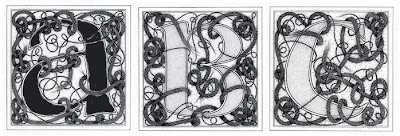 And that did the trick. So, even though this is not what I had planned to do today, I filled in all the letters with black black black Polychromo, and burnished it down, and my arm is sore. But they "read" now, and really pop, and look much better.
And that did the trick. So, even though this is not what I had planned to do today, I filled in all the letters with black black black Polychromo, and burnished it down, and my arm is sore. But they "read" now, and really pop, and look much better. What you can't see when they're shrunk down in size is the detail of the "fuzz" on the yarn where it goes over the black part. I inscribed it with a little tiny skinny crochet hook, and then when I went over the area with the black, the lines stood out.
What you can't see when they're shrunk down in size is the detail of the "fuzz" on the yarn where it goes over the black part. I inscribed it with a little tiny skinny crochet hook, and then when I went over the area with the black, the lines stood out. Fussy, I know.
Fussy, I know.
The next post will be something in color. I promise.
Viewing: Blog Posts Tagged with: Polychromo, Most Recent at Top [Help]
Results 1 - 12 of 12
Blog: Drawing a Fine Line (Login to Add to MyJacketFlap)
JacketFlap tags: Polychromo, black, illuminated letters, Add a tag
Blog: Born to Write (Login to Add to MyJacketFlap)
JacketFlap tags: music, writing, bob dylan, beatles, guitars, beatles, guitars, Add a tag
Why oh why did I quit taking guitar lessons?
(There's a good story there. It involves outing a family member who wishes to remain anonymous in this semi-professional writer-to-writer journal.) ;>
But oh! This kid is on the right path.
Long may she play.
Guaranteed to make you smile. Laugh. And sing along.
That's what a great song can do.
All across the universe (tipping my hat to the Beatles, of course), great words resonate and make sense to people of all ages.
I surround myself with books, hundreds of books (I Can't Stop Buying Them... Save Me Somebody) and pray for the magic in the paper to seep into my skin. I am their assistant. I tap tap tap and hold my breath, willing the trick to work. Presto change-o. Make my words appear. Shazam!
Aint woiyds grand? Where would we be without them?
Blog: Drawing a Fine Line (Login to Add to MyJacketFlap)
JacketFlap tags: Harry Potter, studio, Polychromo, studio, Polychromo, Add a tag
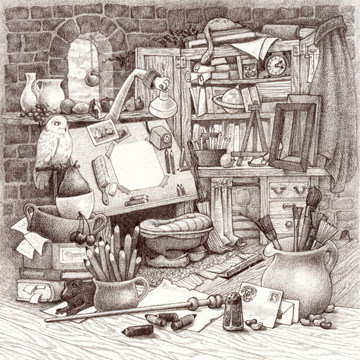
8 x 8
Polychromo pencil on Strathmore Bristol
This is what all those "Walnut Brown" experiments were all about. I finished this today, and the recipient is very happy with it. I am so relieved!
It was a very fun commission. Its an invented artist's studio with some Harry Potterish bits in it, as well as things that are meaningful to the person to whom it now belongs. (that was wordy).
**Update** I now know I have permission to say WHO the mystery recipient is ~
the wonderfully gifted colored pencil artist Nicole Caulfield!!!
She mentions this on her blog and explains what its for.
It was such an honor to do this for her. I am a BIG fan of her work and admire her skill with a pencil tremendously.
I think we achieved the "black and white" idea but warmed it up sufficiently by using the Walnut Brown Polychromo instead.
There's a secret passageway going under the cupboard toward the right, a broom for flying leaning against the drawing table, Hedwig the owl, Bertie Bott's Every Flavor beans down front, an invisibility cloak hanging on the armoire, a chocolate frog, and references to Nicole's work and subject matter she uses in her pieces.
I wish I had a secret passageway in my studio...
All images and content herein are © Paula Pertile and may not be used or reproduced without permission.
Blog: Drawing a Fine Line (Login to Add to MyJacketFlap)
JacketFlap tags: yarn, bristol, Polychromo, yarn, Polychromo, bristol, Rives, Rives, Add a tag
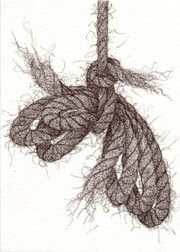
2.5 x 3.5
Polychromo Walnut Brown pencil on BRISTOL
ebay
I thought I'd try one more support. It was kind of a d'oh! thing. I found some good Strathmore 500 Bristol PAPER in my file drawer. The bristol is only 2-ply I think. And so its also "see-thru" on a lightbox, like the Rives in the last post.
Let's see how they compare now: (click to make it bigger)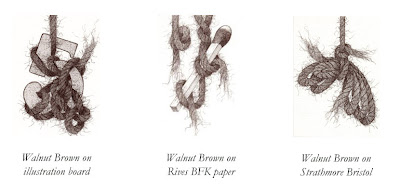
The color isn't as soft as on the Rives, and has some of its punch back. Its a twinge different than the original one done on board. But it comes closer to the original one than the Rives does.
Very interesting (said like the guy on Laugh-In, if you remember that)...
To see all the Yarn pieces in this series side-by-side, please go here. Or visit my ebay store to see which are available for sale.
All images and content herein are © Paula Pertile and may not be used or reproduced without permission.
Blog: Drawing a Fine Line (Login to Add to MyJacketFlap)
JacketFlap tags: illustration board, Polychromo, Polychromo, illustration board, Walnut brown, Rives BFK, Walnut brown, Rives BFK, Add a tag
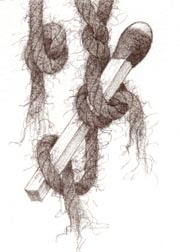
2.5 x 3.5
Polychromo Walnut Brown on PAPER
ebay
I bought some Rives BFK print paper last time I was at the store, and thought I'd better try it!
This is a HUGE departure from my usual illustration board. HUGE I tell you.
I've always loved illustration board for its durablility (doesn't crease easily, its more sturdy) and versatility (you can use all kinds of media on it).
But you can't see through it. That's a major drawback. It makes it really hard to transfer finished drawings, especially for colored pencil work (if you do the usual "lay the drawing down on top and trace over it to transfer it" it leaves a groove in the board, no matter how light a pressure you use, and that's not a good thing for pencil work.)
What I've been doing with the board is this labor-intensive "scan the drawing, clean it up in Photoshop, then print it out really really really really light onto the board with my Epson 2200 printer".
Well, that works, but its kind of a drag. And the printer only goes 13" wide, so if your board is wider than that, then what do you do? You can see the problem. (Except for all of these little pieces ~ I just draw them freehand directly onto the board. I'm talking about more involved illustrations.)
So this paper works with a lightbox. YAY!
And I like the paper. Not as well as the board, but its OK. It doesn't take many layers of pencil. I think it will be good for this monochromatic kind of work where I don't have to do too many layers anyway. But I think for really heavy handed many-colored and layered kinds of work, it wouldn't hold up.
The paper is soft and lovely, but that's the problem. The tooth squishes down too fast (if you do colored pencil you know what I mean by that.)
The other interesting thing is that the Walnut Brown color looks different than it does on illustration board.
Do you see the difference? It looks softer on the paper, and it also doesn't go quite as dark.
I used cream colored paper ~ I think. I know that sounds stupid. I remember there was a grey (which I didn't want) and this. I know they make both white and cream, and I'm pretty sure what I have here is the cream. I guess I get to go back to the store and check, or order some white from online someplace. (I've already searched online, and when looking at the little color swatches of both colors, what I have here actually looks like something in between the two, which is no help at all!)
Remember when art was easy? You just had your little box of crayons and some construction paper?
To see all the Yarn pieces in this series side-by-side, please go here. Or visit my ebay store to see which are available for sale.
All images and content herein are © Paula Pertile and may not be used or reproduced without permission.
Blog: Drawing a Fine Line (Login to Add to MyJacketFlap)
JacketFlap tags: sepia, yarn, illustration board, Polychromo, sepia, yarn, Polychromo, illustration board, Add a tag

2.5 x 3.5
Polychromo on illustration board
ebay
Uno mas. Back to my Polychromos. This was done with "Walnut Brown". Funny, I thought the Sepia color would be darker, but nope. I actually like this a lot.
Wouldn't it be funny if after all this trying out different brands I came back to my Polychromos after all?
(Remember, this was all about finding a warmer alternative to just black.)
I think I might do one or two more, then decide which way to go. I have to get started on the piece, a private commission, that inspired this search in the first place!
To see all the Yarn pieces in this series side-by-side, please go here. Or visit my ebay store to see which are available for sale.
All images and content herein are © Paula Pertile and may not be used or reproduced without permission.
Blog: OUPblog (Login to Add to MyJacketFlap)
JacketFlap tags: Music, Reference, UK, records, A-Featured, Online Resources, online, popular, pop, larkin, bbc, beatles, blues, oupblog, springfield, Add a tag
By Kirsty OUP-UK
This week I’m delighted to be able to bring you another post from Colin Larkin, editor of The Oxford Encyclopedia of Popular Music. In his last post for the OUP blog, Colin told us what he thought of Christmas records. This time around he explains why he really believes video killed the radio star. Do you agree with him? Let us know in the comments box below!
Ah the 60s. Catch a last lingering whiff of patchouli while the musical decade which changed the world slowly fades and the protagonists, movers and shakers retire or die.
(more…)
Blog: The Mumpsimus (Login to Add to MyJacketFlap)
JacketFlap tags: Movies, Music, film, Bob Dylan, Beatles, Todd Haynes, Julie Taymor, Add a tag
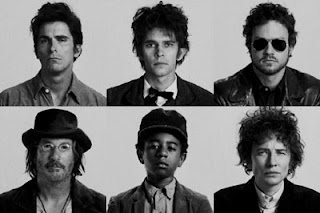
Thanksgiving is a hit-or-miss holiday for me -- I've had some wonderful ones with friends and family, but some of my favorite Thanksgivings have been ones where I've hung out on my own and taken a break from everything. This year was one of those, and a memorable one, because I decided to see two movies I was sure would be interesting to see together: I'm Not There and Across the Universe.
Both films are based on the work of some of the most recognizable, revered, and influential musicians of the last fifty years: Bob Dylan for I'm Not There and The Beatles for Across the Universe -- musicians who came of age and influence at roughly the same time. Both films are helmed by idiosyncratic directors: Todd Haynes and Julie Taymor. Both films have gotten wildly divergent responses from viewers.
I am far more of a Bob Dylan fan than a Beatles fan (though I did go through a bit of Beatlemania as a kid, and so most of the words to their best-known songs come immediately to mind if I hear only a few notes). I am far more of a Julie Taymor fan than Todd Haynes fan (his films often seem thoughtfully imagined, intelligently constructed, and mostly lifeless to me). I went into each movie trying to watch it as an artifact of its own, something toward which I would bring as few preconceptions as possible, for fear of being disappointed about either a director I respect or a body of music that has been important to my life. In particular, I wanted to see the movies as movies, not as movies about Dylan or the Beatles.
It proved impossible to watch I'm Not There without always thinking about Dylan. That shouldn't be surprising for a film that says it is "inspired by the music and many lives of Bob Dylan", but still -- I had read Anthony Lane's review, and even without seeing the movie I knew there was no way anyone could enjoy it if they had such a literal, flatfooted approach as Lane did. I had thought the best way to really enjoy the movie was not to try to connect the dots between Dylan and the kaleidoscopic hallucination of his life and music that the film presents, but rather to enter into the hallucination, to let it go without reference to anything other than itself.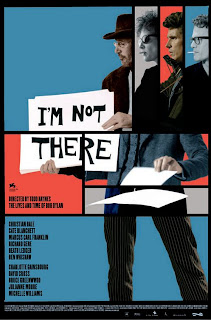 Easier said than done. And not necessary, either. Here's the thing you need to be able to enjoy this movie: you need to like Bob Dylan's music. If you don't, you're doomed, because that music plays almost constantly through the film. But if you like Dylan's music, you've got a chance. You then need to watch the movie the way you listen to a Dylan song, with an open mind and a willingness to not get all the references, but to enjoy their presence nonetheless. Instead of making a biopic, Todd Haynes has made the cinematic equivalent of a Dylan concert.
Easier said than done. And not necessary, either. Here's the thing you need to be able to enjoy this movie: you need to like Bob Dylan's music. If you don't, you're doomed, because that music plays almost constantly through the film. But if you like Dylan's music, you've got a chance. You then need to watch the movie the way you listen to a Dylan song, with an open mind and a willingness to not get all the references, but to enjoy their presence nonetheless. Instead of making a biopic, Todd Haynes has made the cinematic equivalent of a Dylan concert.
Dylan has often been described as a magpie (or, less charitably, a thief), and what Haynes has done is similar -- he has taken not only Dylan's life and work, but many of his influences, and from them he has built his structure out of riffs and allusions, quotations and transpositions, dreams, fantasies, rumors, myths, and the iconography of an array of cultural moments. Haynes has a semiotics habit, and he deconstructs one sign after another, sticking them all up on different posts to point the way toward something ineffable. (A town called Riddle figures prominently.)
Very little in I'm Not There is a one-to-one allusion where x = y. Instead, in the best moments, like some of the best moments of Dylan's best songs, the allusions are so many that they gain weight of their own -- the gravity of synergy, perhaps -- and so we have, for instance, scenes that reference Fellini, A Hard Day's Night, Don't Look Back, and much more. Such scenes become so overdetermined that the references don't really matter, except for a chuckle or nod, and we are left to consider that first-and-last refuge of the inveterate postmodernist: the surface.
Something else Haynes has done is show us how powerful the music is. (Not that those of us who have spent much of our lives listening to Dylan ever really needed anybody to tell us the music is powerful -- but I'm Not There provides the sort of defamiliarizing jolt that reminds us what resides within those notes and words.) Both I'm Not There and Across the Universe succeed by letting the music do the emotional work, but not (usually) in the crassly manipulative way of so many middling movies, the kind that underscore every climax with strings, treating their audiences like a kennel of Pavlovian dogs. I'm Not There busts its main character into six personas and tells a nonlinear, associational story with a panoply of film stocks and styles. That's a recipe for an intellectual adventure, not an emotionally satisfying experience, and while I don't think all art needs to be an emotionally satisfying experience, the evocation of emotion within nonlinear, associational forms is, it seems to me, a great artistic accomplishment -- one I appreciate in everyone from Joseph Cornell to David Markson, Virginia Woolf to Paul Celan.
The music in I'm Not There works as a link and a lifeline, a depth charge blowing the images and story to bits, leaving a ghost of electricity to shock us. All of the characters are more glimpses than they are full people, though some, because they fit into the cozy outlines of a more familiar biopic, fill up on our extrapolations. Scenes of loss and loneliness become immensely powerful not because we have any real dramaturgy warming us up for emotional exercise, but because the music is deployed so skillfully that it combines with the images to give us more information than we would ever have otherwise, and it provokes a reaction.
Haynes shifts cinematic tones again and again throughout the film, but the music remains that of Dylan, and even the songs that are performed by other musicians are mostly so faithful to his versions that the soundtrack eases us over bumps that should, by all rights, be more upsetting. Pastoral scenes alternate with parodies, goofy surrealism keeps close company with historical reconstructions. It shouldn't work. It does.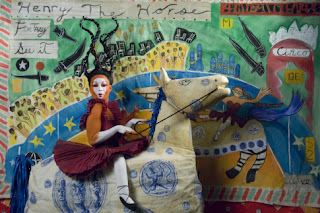
Across the Universe shouldn't work, either, but it does. Unlike I'm Not There, Across the Universe tells a linear story, but it is almost as out of the ordinary, because the story it tells is episodic and even occasionally epic, containing big musical numbers (with precise and sometimes wondrous choreography), psychedelic set-pieces, moments of quiet intimacy, caricatures side-by-side with characters, and a hippie-dippy love-conquers-all ending. What's not to love?
Julie Taymor is a wonderfully visual theatrical artist, but she has not yet had a movie that allowed her to express her visual talents as fully as Across the Universe does. I love both Titus and Frida for their exuberance and the depth of their designs, but Across the Universe goes even farther, giving Taymor the opportunity not only to work with two-dimensional backgrounds, extraordinary props and costumes, masks, and other elements present in her previous films, but also with giant puppets and extended scenes of bizarre fantasy (some of this is visible in a few of the film's YouTube clips, such as with Eddie Izzard as Mr. Kite. I was particularly happy to see Taymor get to use puppets based on those of Bread & Puppet, with whom she studied briefly.)
The characters in Across the Universe are more developed than those of I'm Not Here, and the music serves a more familiar purpose, a purpose common to most musicals: it cuts in when the characters are in the grips of strong emotion or they need to express themselves more forcefully. Here, too, though, the songs provide a particular richness to the film, because the story is generally predictable and sometimes feels composed of outtakes from Forrest Gump, but almost every bit of it is redeemed by the imagery and the music (I don't think the brief war scenes quite come off -- they don't feel much different from the other scenes in the film, when really, to motivate much of what happens, they should hurt more).
The two films overlap in their suspicion of idealism. The folk song era is portrayed in I'm Not There through gentle parody, with the tales of the young and earnest Dylan figure told in a documentary style that calls to mind A Mighty Wind and Bob Roberts more than No Direction Home. The protagonists move farther and farther away from commitment (of all sorts), though they are chased and hounded by interviewers and authorities who try to make them bow down or take a stand. In Across the Universe, the ravages of the Vietnam war radicalize Lucy until she almost loses sight of everything, and everybody who believes fervently in a cause -- whether soldier or civilian -- gets beaten, broken, bombed. The survivors in Across the Universe are the folks who never went too far, or if they did, they turned around before too late. Via different paths, the two films seem to support an ideology of transcendental individualism: Nobody gets to change the world, but they do get to change themselves, and if enough selves change, then the world changes, too.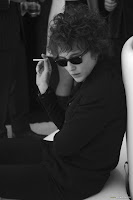
Because I was so taken by what the writers, directors, and designers of these two movies accomplished, I have said little about the performers, but each film is well performed and sometimes extraordinarily performed. (From I'm Not There, Marcus Carl Franklin and Cate Blanchett deserve particular accolades.) I was particularly surprised by Bono in Across the Universe -- he's a riot, and, at least until he sings, nearly unrecognizable. The young actors in the main roles all perform with great energy and commitment, making scenes that would have induced cringes of embarrassment were the actors less confident into real delights.
Delight, in fact, is what I felt after each film. I'm Not There is overall a greater accomplishment, I think, than Across the Universe -- its form is more innovative, its philosophy more nuanced -- but there's really no need for such a judgment, because both movies are more entertaining and thought-provoking than all but a few of the other films produced in the U.S. this year, and each will, I'm sure, reward rewatching. In fact, I'd be happy to see both movies again tomorrow if I had time, and it's rare that I encounter one film a year I can say that about, never mind two in one day.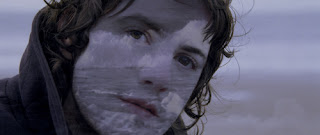
Blog: Sugar Frosted Goodness (Login to Add to MyJacketFlap)
JacketFlap tags: beatles, Phil McAndrew, SFG: Rock Legends, Add a tag
Blog: The Excelsior File (Login to Add to MyJacketFlap)
JacketFlap tags: music, biography, middle grade, nostalgia, beatles, boomers, Add a tag
The Beatles, Beatlemania and the Music That Changed the World by Bob Spitz Little Brown 2007 I'm wondering of, when I was a middle school aged grunt, if I even knew about music and musicians that were popular 40 years earlier. That would have been the music between the wars, music of a country climbing out of the Great Depression. The biggest hit songs would have been Fred Astaire and Ginger
Blog: OUPblog (Login to Add to MyJacketFlap)
JacketFlap tags: music, boy, UK, Current Events, oxford, madonna, george, studio, A-Featured, oup, press, beatles, university, ball, corby, casino, sixties, adam, ant, 54, Add a tag
By Kirsty OUP-UK
Saturday 16 June 2007 saw the Oxford offices of OUP transformed for one night only: the Oxford University Press Ball. These momentous nights only take place every few years, so it really is a special occasion. Below, for your viewing pleasure, are some photographs from the night in question. (more…)
Blog: OUPblog (Login to Add to MyJacketFlap)
JacketFlap tags: Music, band, History, Love, Reference, Summer, Current Events, Oxford, hearts, A-Featured, Online Resources, Dictionary, Leisure, club, peppers, lonely, underway, beatles, 1967, St, of, Add a tag
So yesterday was the anniversary of one of the most amazing musical moments of all time, the release of St. Peppers Lonely Hearts Club Band. The album kicked off the Summer of Love (we can only hope this summer is 1/10 as exciting) and everything changed. The Oxford Dictionary of National Biography and the American National Biography celebrated the event with an interactive album cover. To trip just click.




Paula, I love these, but then I would, I'm an embroiderer! Your crochet hook technique is just what I need for a portrait I'm doing of my grandson - thanks for the tip!!!
absolutely beautiful and the black is really necessary :>)
Paula, I love this whole idea for this series - wonderful! (I see this is schools everywhere!) And, yes, you made a good choice to darken the letters, they really pop!
AWESOME! I would be tempted to stop now at ABC... kind of like learning your ABC's.. good enough for me, but then you said you're fussy... and for good reason, it's making us all so HAPPY! I love how you explained the little white fuzz lines on the black... you got everything down just RIGHT! Perfecto!!! xo Rose
Gads Girlie, these are beautiful!
Btw, TAG you're it!! I've tagged you for a fun game which you can read about here:
http://dulemba.com/2008/04/ive-been-tagged.html
:)
e
I haven't been by for awhile. These are so COOL! But inquiring minds want to know what you're going to do with them. They're too pretty to languish.